九年级英语全册Unit8ItmustbelongtoCarla第3课时教案
- 格式:doc
- 大小:352.50 KB
- 文档页数:5
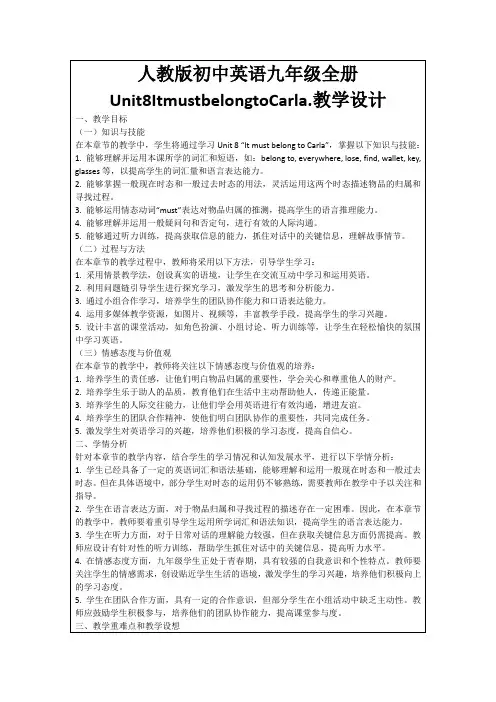
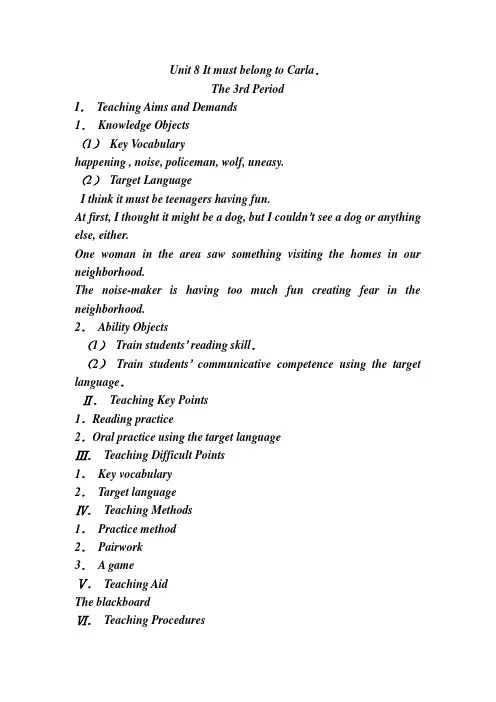
Unit 8 It must belong to Carla.The 3rd PeriodI.Teaching Aims and Demands1.Knowledge Objects(1)Key V ocabularyhappening , noise, policeman, wolf, uneasy.(2)Target LanguageI think it must be teenagers having fun.At first, I thought it might be a dog, but I couldn’t see a dog or anything else, either.One woman in the area saw something visiting the homes in our neighborhood.The noise-maker is having too much fun creating fear in the neighborhood.2.Ability Objects(1)Train students’ reading skill.(2)Train students’communicative competence using the target language.Ⅱ.Teaching Key Points1.Reading practice2.Oral practice using the target languageⅢ.Teaching Difficult Points1.Key vocabulary2.Target languageⅣ.Teaching Methods1.Practice method2.Pairwork3.A gameⅤ.Teaching AidThe blackboardⅥ.Teaching ProceduresStep I RevisionRevise the usage of the words must, might, could and can’t by checking homework.Ask students to exchange their exercises books and help correct any errors with each other, As they are doing this, move around the classroom offering language support as needed.Then invite different students to say their sentences to the class.Step Ⅱ3a1. Read the article and decide which might be the best title.A.A Small and A Quiet Town.B.Strange Happenings in My Town.C.Animal in Our Neighborhood.2. Read the article again and find the key words and the key sentences.3. Explain the key words and the key sentencesStep Ⅲ3b1.Read the article and find words to match the meanings.2.Check the answers.Step Ⅳ3c1.Read the article carefully and write what people think about the strange noises.2.Check the answers.Step ⅤSummarySay, In this class, we’ve learned some vocabulary words, such as drop, symphony.And we’ve done much oral practice using the target language.Step ⅥHomework1.Read the letter in Activity 3a again for further understanding of the vocabulary words.2.Write the key sentences.。
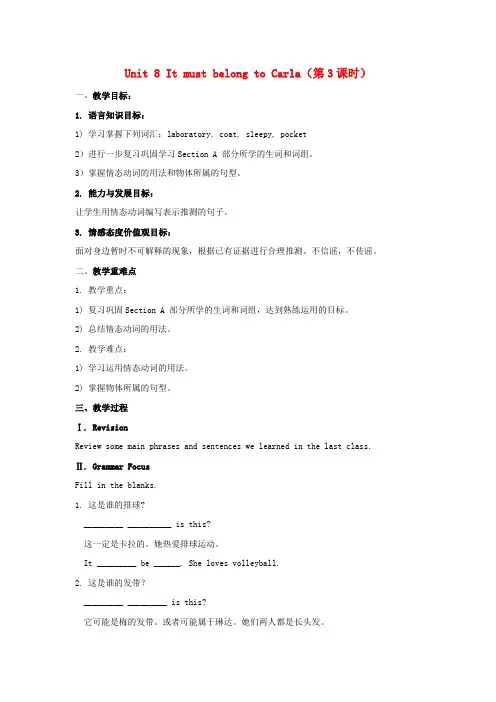
Unit 8 It must belong to Carla(第3课时)一、教学目标:1. 语言知识目标:1) 学习掌握下列词汇:laboratory, coat, sleepy, pocket2)进行一步复习巩固学习Section A 部分所学的生词和词组。
3)掌握情态动词的用法和物体所属的句型。
2. 能力与发展目标:让学生用情态动词编写表示推测的句子。
3. 情感态度价值观目标:面对身边暂时不可解释的现象,根据已有证据进行合理推测。
不信谣,不传谣。
二、教学重难点1. 教学重点:1) 复习巩固Section A 部分所学的生词和词组,达到熟练运用的目标。
2) 总结情态动词的用法。
2. 教学难点:1) 学习运用情态动词的用法。
2) 掌握物体所属的句型。
三、教学过程Ⅰ. RevisionReview some main phrases and sentences we learned in the last class. Ⅱ. Grammar FocusFill in the blanks.1. 这是谁的排球?_________ __________ is this?这一定是卡拉的。
她热爱排球运动。
It _________ be ______. She loves volleyball.2. 这是谁的发带?_________ _________ is this?它可能是梅的发带。
或者可能属于琳达。
她们两人都是长头发。
It _____ be Mei’s hair band. Or it ______ belong to Linda. They___ have long hair.3. 那晚你看见了什么?______ did you see that night?我不确定,但肯定不可能是狗。
它更大。
我想也许是一头熊或一匹狼。
I'm ____ _____, but it ____ _____a dog.It was bigger. I think it ____ _____ a bear or a wolf.Ⅲ. Try to Find情态动词表推测,可能性:must> can/could> may/might一、must表示可能性最大的肯定推测,意思是“一定、准是”。
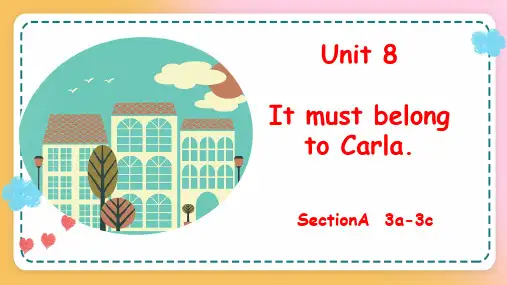
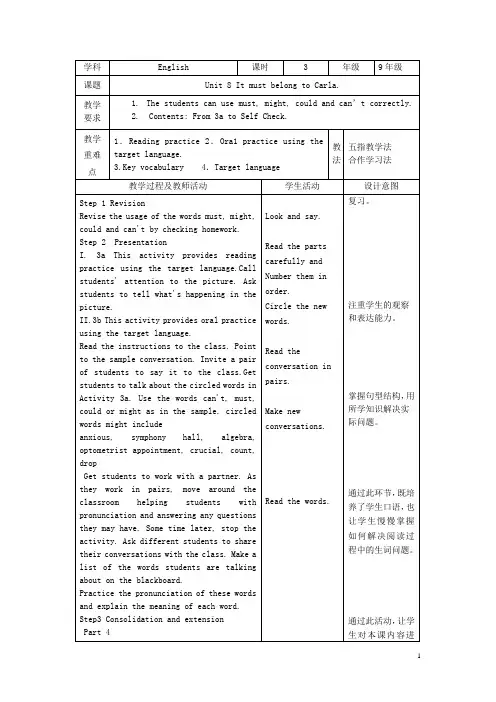
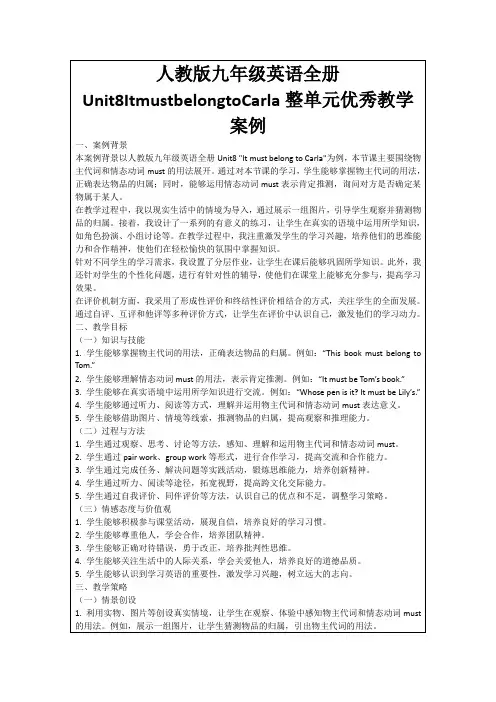
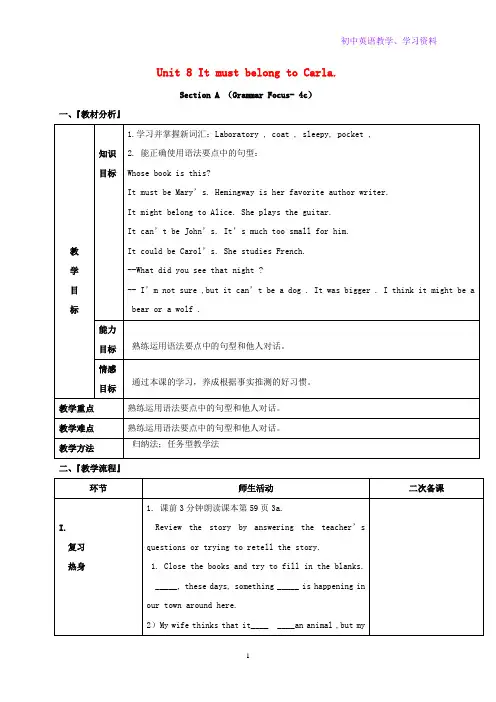
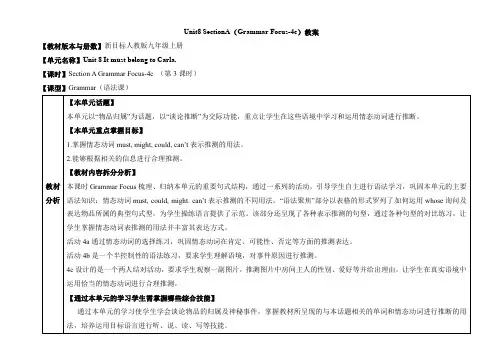
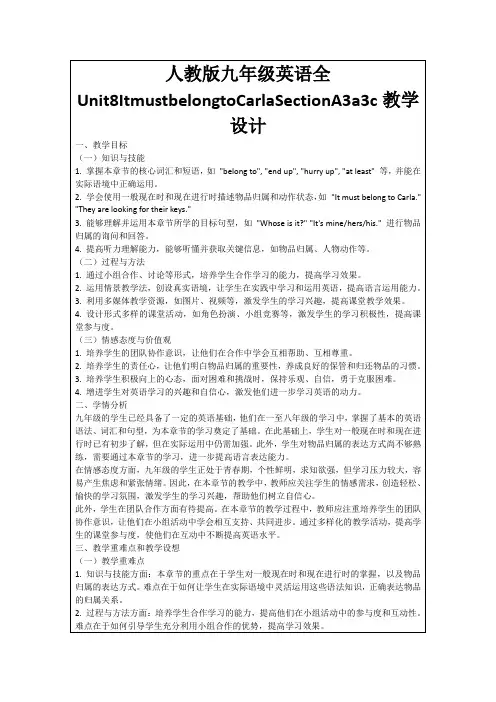
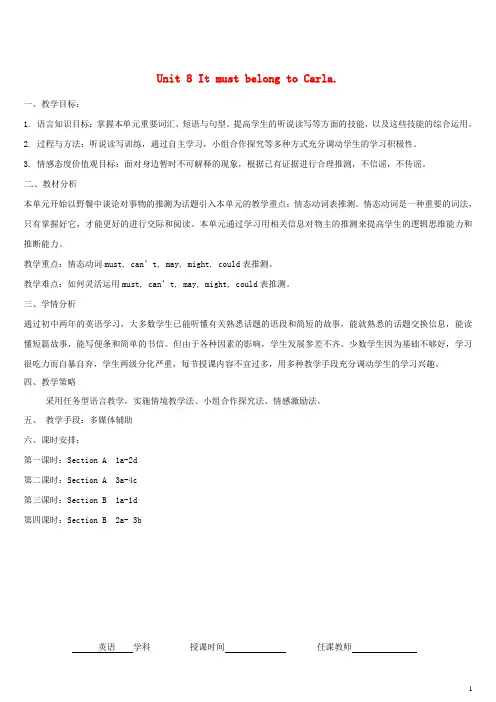
Unit 8 It must belong to Carla.一、教学目标:1. 语言知识目标:掌握本单元重要词汇、短语与句型。
提高学生的听说读写等方面的技能,以及这些技能的综合运用。
2. 过程与方法:听说读写训练,通过自主学习,小组合作探究等多种方式充分调动学生的学习积极性。
3. 情感态度价值观目标:面对身边暂时不可解释的现象,根据已有证据进行合理推测,不信谣,不传谣。
二、教材分析本单元开始以野餐中谈论对事物的推测为话题引入本单元的教学重点:情态动词表推测。
情态动词是一种重要的词法,只有掌握好它,才能更好的进行交际和阅读。
本单元通过学习用相关信息对物主的推测来提高学生的逻辑思维能力和推断能力。
教学重点:情态动词must, can’t, may, might, could表推测。
教学难点:如何灵活运用must, can’t, may, might, could表推测。
三、学情分析通过初中两年的英语学习,大多数学生已能听懂有关熟悉话题的语段和简短的故事,能就熟悉的话题交换信息,能读懂短篇故事,能写便条和简单的书信。
但由于各种因素的影响,学生发展参差不齐。
少数学生因为基础不够好,学习很吃力而自暴自弃,学生两级分化严重,每节授课内容不宜过多,用多种教学手段充分调动学生的学习兴趣。
四、教学策略采用任务型语言教学,实施情境教学法、小组合作探究法、情感激励法。
五、教学手段:多媒体辅助六、课时安排:第一课时:Section A 1a-2d第二课时:Section A 3a-4c第三课时:Section B 1a-1d第四课时:Section B 2a- 3b英语学科授课时间任课教师whose, truck, picnic, rabbit, attend, valuable, pink, anybod听力策略培养) policema n wolf uneasy laboratory coat sleepy教师活动展示对情态动词表推测的用法进行归纳总结,掌握其规则英语学科授课时间任课教师cHe might be running to catch a bus to work.老师总结各小组成绩,与学生自主评价相结合英语学科授课时间任课教师hard-worki ng, medical purpose解决方法。
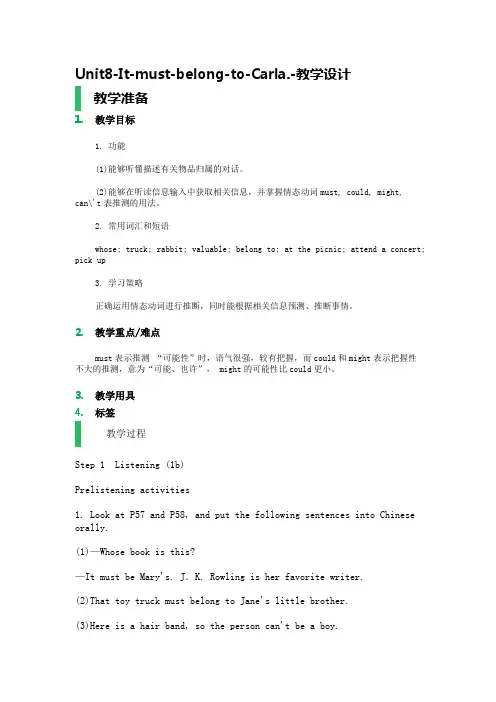
Unit8-It-must-belong-to-Carla.-教学设计教学准备1. 教学目标1. 功能(1)能够听懂描述有关物品归属的对话。
(2)能够在听读信息输入中获取相关信息,并掌握情态动词must, could, might,can\'t表推测的用法。
2. 常用词汇和短语whose; truck; rabbit; valuable; belong to; at the picnic; attend a concert; pick up3. 学习策略正确运用情态动词进行推断,同时能根据相关信息预测、推断事情。
2. 教学重点/难点must表示推测“可能性”时,语气很强,较有把握,而could和might表示把握性不大的推测,意为“可能、也许”, might的可能性比could更小。
3. 教学用具4. 标签教学过程Step 1 Listening (1b)Prelistening activities1. Look at P57 and P58, and put the following sentences into Chinese orally.(1)—Whose book is this?—It must be Mary's. J.K. Rowling is her favorite writer.(2)That toy truck must belong to Jane's little brother.(3)Here is a hair band, so the person can't be a boy.(4)But then the schoolbag could belong to Rita.(5)She's always forgetting things.(6)Then it must be Linda's schoolbag.2. Put the following sentences into English orally, and then write them down without looking at the text.(1)它一定是卡拉的。
Unit 8 It must belong to Carla.Section A (3a-3c)Ⅰ. Teaching objects1. Knowledge objects1) Learn to make inferences with “must”, “might”, “could”, and “can’t”.2) Talk about the words you don’t understand or something that worries you.2. Ability object1) Enable the students to infer the owners of the things using “must”, “might”,“could”, and “can’t”.2) Train students’ reading skill.3. Emotion goalEnable the students to learn to cooperate with others actively and gladly and develop their team spirits.Ⅰ. Teaching key points and difficult points1. Teaching key pointsLearn to make inferences using “must”, “might”, “could” and “can’t”.2. Teaching difficult pointsLearn to make inferences using “must”, “might”, “could” and “can’t”.Ⅰ. Teaching methodsTask-based Language Teaching; Computer-Aided Instruction; The Situational Mthod Ⅰ. Teaching proceduresStep 1 Lead-inQ: How do you feel when you hear something strange every night, but you can’t see anything?(Ask Ss to talk about their feeling and lead Ss to master new words.)Step 2 Pre-readingTask: Prediction: Ask the students to look at the picture on Page 59 and answer the questions:(1) What can you see in the picture?(2) How does the woman feel?(3) What may she see?Check their answers with the whole class. (Through when, where, why, how and so on to talk about what happened in this small village.)Step 3 Fast-readingTask 1: Tell Ss to read the article and decide which might be the best title.A. A Small and Quiet TownB. Strange Happenings in My TownC. Animals in Our NeighborhoodTask 2: Tell Ss to match the main idea with each paragraph.Para. 1 The writer’s opinion about the strange noises.Para. 2 Something unusual is happening in our town.Para. 3 People’s ideas about the strange noises.Step 4 Careful-readingTask 1: Ask Ss to read Para. 1, finish the mind map and fill in the blanks.Q: What are the people’s opinions about strange noises?Task 2: Read Para. 2 and fill in the blanks.Who gave opinions?What are the opinions?Helen She thought it ____ a dog at first, but now sheguesses it ____ a dog.One woman in the area She thinks it may be ______.Task 3: Read Para. 3 carefully and answer the questions.➢How do the people in the town feel now?➢What is the writer’s opinion?Task 4: Read the passage again, and find words to match the meanings in 3b.Pair work:(1)Read the article again and find words to match the meanings.nervous or worried ________ young people ___________person in the next house __________ area where people live ______________ animal like a very large dog ________ person who makes noise ________ (2)Check their answers.Step 5 Group work(1) Ask Ss to read the article carefully and write what people think about the strange noises.Who gave opinions?What are the opinions?Victor’s wifeVictor and his friendsThe policemenHelenOne woman in the areaThe writer himself(2) Get the students to make sound just like the one which is described in the article and praise the winners.(3) Get the students to find out another sentence about inference in the last paragraph. Step 6 Post-reading1. Make an interview: Who was the noise-maker?Students work in group and choose their favorite character and then make a short interview to retell this story.2. Lead Ss to know when they face strange things, they should …Step 7 Language points1. Nothing much ever happened around here.happen不及物动词,意为“发生”,没有被动语态。
Unit 8 It must belong to Carla〔第3课时〕一、Teaching aims:1. Knowledge aims:1) words: policeman, noise, wolf, happening, uneasy2.Ability aims1) The ability of reading for specific information.2) To improve students’ reading ability.二、Teaching important and difficult points1. Teaching important points:1)Master the new words and phrases.2) Read for some useful information.2. Teaching difficult points:1) Master some reading skills.2) Understand and learn to use the words and phrases.三、Teaching proceduresI. RevisionII. PresentationPresent the new words in the dialogues.A: Do you hear strange noise s outside our windowB: Yes, something unusual is happening in our town.A: My father called the policeman, but he couldn’t find anything strange. B: Maybe it was a wolf, everyone in our town is feeling uneasy.III. ReadingWork on 3a:1.Tell Ss to read the article and decide which might be the best title.A.A Small and Quiet TownB.Strange Happenings in my townC.Animals in our neighborhood2. Read quickly and try to find out the main idea of each paragraph.3. Check the answers.IV. Careful Reading1. Work on 3b:1). Read carefully and finish 3b.2). Ask students to discuss with each other and then check the answers.2. Work on 3c1). Read the article carefully and write what people think about the strange noises.2). Ss work in pairs. Let students discuss the answers.3). Check the answers with the students.V. Language points1.It used to be very quiet.used to do sth 曾经,过去常常〔现在不做了〕be used to do sth. (=be used for doing sth.) 被用来做……be used to doing sth 习惯于做……2. However, these days, something unusual is happening in our town.构成:不定代词+形容词 (定语后置)e.g. something importantun- 表示否认 usual 通常的 unusual 不平常的happy 快乐的unhappy 不快乐的3. Victor, a teacher at my school, is really nervous.a teacher at my school 在句中作同位语。